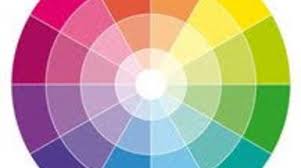
大脑无法准确记忆颜色
Color You Remember Seeing Isn't What You Saw
大脑无法准确记忆颜色
People tend to remember a color they saw, for example green-blue teal, as being closer to a more stereotypical variant, such as straight blue or green. Karen Hopkin reports
当大脑在记忆颜色时,会对颜色信息进行简化,比如将蓝绿色直接记忆成蓝色或者绿色。
撰文/播音 凯伦·霍普金(Karen Hopkin)
翻译 李轩
What color is your living room? Beige? Maybe eggshell? Or is it cream, buff, ecru, khaki, or warm desert sand? Chances are you have no idea, and you wouldn’t be able to pick the shade out of an off-white lineup.
你的卧室是什么颜色?米黄色?蛋壳黄?还是奶油黄、浅黄、黄褐、卡其色或沙漠黄?有极大可能你无法区别这一系列渐变的颜色。
But before you go blaming your eyes, a new study suggests that the fault lies in our brains, which fail to commit to memory the actual colors we see. The findings are in the Journal of Experimental Psychology. [Gi-Yeul Bae, Maria Olkkonen, Sarah R. Allred, and Jonathan I. Flombaum, Why Some Colors Appear More Memorable Than Others: A Model Combining Categories and Particulars in Color Working Memory]
是你的眼睛出问题了吗?先别急着下结论,一项新研究显示,问题出在了大脑——我们的大脑并不能准确记忆眼睛实际看到的颜色。这个发现发表在了《实验心理学》期刊上。
To figure out why we’re not so good at recalling hues, researchers first had subjects look at what’s called color wheel on a computer screen. The wheel included 180 shades in a circle, and subjects were asked to find what they considered the best example of, say, the color blue. Turns out, most people agree on which shades are most representative of a given color—like a robin’s egg blue for the truest blue or a parakeet-like color as the greenest green. Shades like teal, which falls between green and blue, got the fewest votes.
为了弄清楚我们为什么不善于记忆颜色,研究人员首先让受试者观察电脑屏幕上被称为色环的图像。色环包含了180种渐变色,受试者需要在其中找到与给出颜色,比如蓝色,最匹配的颜色。结果,大多数人都可以正确找到能最大程度代表给出颜色的色块,比如将知更鸟蛋蓝匹配到标准蓝或者将长尾鹦鹉色匹配到标准绿,而像野鸭色这样介于蓝绿之间的色块,则很少人会选择。
Then came the memory bit. A second group of volunteers looked at the computer screens. This time, a colored square would appear briefly and, about a second after it disappeared, subjects were asked to find that color on the wheel. The result: people tended to skew their answers toward the colors that had previously been identified as being the best specimen of that color, no matter what color they’d actually seen. That is, if they briefly saw a teal square—which is bluish green (or greenish blue)—some volunteers would remember it as being more blue than it was, while others would swear it was more green.
而另外一个受试小组则在电脑屏幕前进行记忆测试。在这个测试中,屏幕上会短暂地出现一个色块,色块消失1秒后,受试者需要找到色环上与之对应的颜色。结果,无论受试者实际看到的是什么颜色,他们给出的答案都会和标准色有所偏差。也就是说,对于野鸭色块,即蓝绿色块,一些受试者会将其记成更蓝的颜色,而其他志愿者会记成更绿的颜色。
The findings suggest that our brains tend to categorize from just a few choices when filing away colors. So though a sunset might be unforgettable, its many subtle colors are actually impossible to recall.
这个发现表明我们的大脑在记忆信息时会削弱对颜色的记忆。所以,夕阳红虽壮观难忘,但我们并不能记住所有的颜色细节。
未经书面许可任何人不得复制或镜像
京ICP备11000850号-1
 京公网安备11010502039775号
京公网安备11010502039775号 信息网络传播视听节目许可证0111611号
国家科技基础条件平台

















